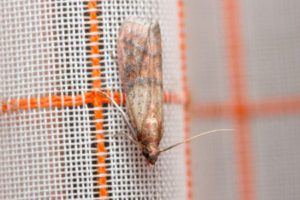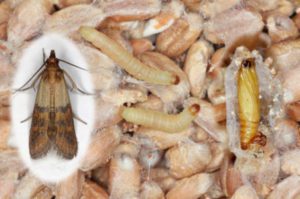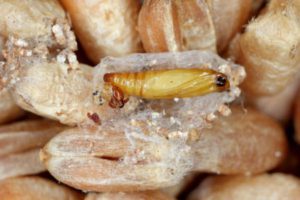EXTRA STORED FOOD CAN RESULT IN FOOD MOTHS AND BEETLES!
By Zachary Ciras on February 18, 2021.
A recent blog post discussed a potential increase in residential mouse infestations as more people are storing greater amounts of packaged and bulk foods in their homes (see Extra Stored Food Can Mean Extra Mice!). More food on shelves and in boxes can also mean increased risk of stored food pests (or “pantry pests” as some call them) such as flour beetles, grain beetles and grain moths, rice weevils, and others.
These insects infest the foods that we or our pets eat, often even those still in sealed packages. The larvae do most of the feeding damage and can contaminate the products they are feeding on with feces and webbing. After pupation, the adult beetles and moths disperse to mate and lay eggs in more food products.
THE INDIAN MEAL MOTH IS PANTRY PEST #1

Indian meal moth, Plodia interpunctella, posed on a fabric curtain
Probably the number one stored food pest in homes is the Indian meal moth (IMM). An infestation of these moths is usually first noticed in one of three ways: (1) small adult moths flitting around at dusk (they’re attracted to lights), (2) white or pinkish, hairless caterpillars climbing up walls or spinning pupal cocoons in ceiling or cabinet corners (see What Are Caterpillars Doing in My Kitchen?), (3) larvae or loose webbing, shed skins, and larval fecal pellets in food materials.
By the time you notice any of the above three clues, the infestation has been going on for some time. Then, besides eliminating the insects that you see, you have to find the source of the moths, the food product or products where the larvae are feeding. Adult moths do not feed.
Indian meal moths, Plodia interpunctella, are about 3/8-inch long with their wings held back. Their wings are gray nearer the head with a coppery band across the tips. The caterpillar-like, fully-grown larvae are about ½-inch long with barely visible short legs and a brown head. When ready to pupate, the larva leaves the food material, generally crawling upward to spin a cocoon in a protected corner (see Meal Moths Leave Cocoons Behind).
HOW TO LOOK FOR MOTH OR BEETLE-INFESTED FOODS

Pupae larvae and adult insect of Indian mealmoth Plodia interpunctella of a pyraloid moth of the family Pyralidae. It is common pest of stored products and pest of food in homes.
The foods most likely to be infested by food pests are those that have been on the shelf the longest, or are in packages that have been damaged or gotten damp, are overlooked, or stored in dark areas. Even unopened bags or boxes can be infested. You may want to dump the contents out onto a cookie sheet to look for evidence of the presence of adults or larvae in the product.
If evidence of infestation is found, discard the infested products and wash down shelves. Food that might be infested or is at high risk can be placed in a deep freezer for several days to kill any eggs or larvae. You may want to have a pest control company treat shelves and other areas to kill any new larvae that may hatch from eggs in cracks and crevices.
To complicate the issue, the food source of stored food pests is not always obvious “food.” Indian meal moth larvae especially like dry pet food so that huge bag of Doggie Crunchies in the garage can be the source of the infestation. Larvae can also infest food-related items in other areas of the house such as Indian corn ornaments or jewelry, bean or pasta mosaic pictures, dried herbs or flowers, bean bag toys, birdseed, tropical fish food, even hidden chocolate candy.
A MOUSE INFESTATION CAN LEAD TO AN INDIAN MEAL MOTH INFESTATION
As an interesting aside, there is actually a connection between mice and Indian meal moths (The Indianmeal Moth – Mouse Connection Explained). Mice are known to collect and store food in hidden areas, supposedly for later consumption. Dry pet food or birdseed, for example, may be cached by mice in a wall or ceiling void. If this food hoard is discovered and infested by Indian meal moths (or any stored food pest), it can be extremely difficult to find the hidden location of the infestation and it can continue unchecked for a long time.

Pupa of Indianmeal moth Plodia interpunctella on grain
It can take months to completely eliminate food moths or beetles since they can feed on so many different items in different parts of a home. Our Colonial Pest technicians can help with all aspects of a food pest infestation – from pest ID, to inspection, to treatment and follow-up monitoring. We even offer advice on how best to store your food to keep it pest-free. Call Colonial Today!